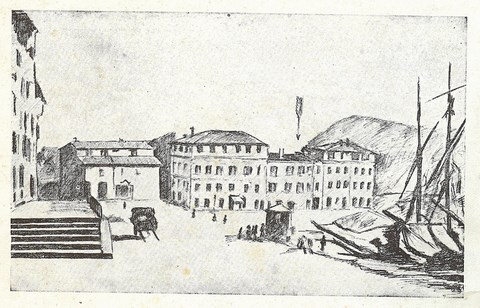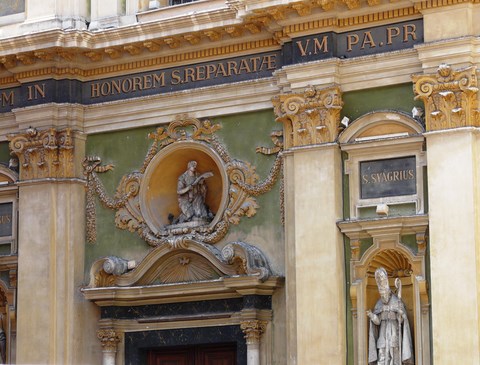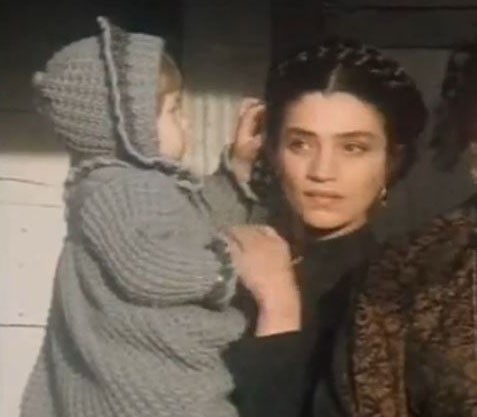Battistina Ravello (1830-1906)
Who was Battistina Ravello?
Battistina Ravello’s birth name is Teresa Battista Raveu.
In Nice, people would often use their second name as first names. Battistina is Battista’s nickname. Was it Garibaldi, who had renamed her, as he often would do with women, for example he renamed Anna Maria, Battistina’s daughter Annita, certainly as a tribute to his first wife.
Raveu is prononced in Nice Raveou. Depending on the time, the writtern transposition in official acts would range from Raveu to Ravel, or Ravello (for men), Ravella (for women), Ravelly, Raveo, Revel, Revello, Revelly.
She had 8 siblings and was the last child. 6 of them survived past infancy: Teresia, Giuseppe, Carlo Andrea Antonio, Onorato, Augusto and Filippo.
The family seems to have always lived in the port area of Nice. In 1822’s census their house was located at the Col de Villefranche. It is at this address (8, Rue Montboron) that Giuseppe Raveu, Battistina’s father died aged 83 in 1867. The death certificate explains he had been awarded the medal of St. Helena; some research on the actual facts of the war at the origin of this distinction would be benefitial, given that Giuseppe was born in 1783. He was a farmer as evidenced by a few official documents: eg in the Honorine’s birth certificate in 1883, His granddaughter’s birth certificate in 1848, and his death certificate in 1867. He became homeowner in 1830 as evidenced by the mortgage register (page 53 of 103, Volume 114, Page 101). It seems [1] that he owned a parcel of 24 acres planted with olive trees. He was not a seaman as was sometimes reported.
___________________________________________
[1] According to the land registry, Joseph Raveu owned a plot No. 14 of section D (on the Col de Villefranche) in St. Roch district, which was 24 acres and 20 centiares planted with olive trees. This land was located on the ground along the road from the Grande-Corniche (Bd Bischoffen, formerly known as Genoa way) in Villefranche-sur-mer and now called Boulevard-des 2 corniches. This is where he was living with his daughter Teresia as per 1861’s census. Now there are houses
Battistina’s life
When she left Nice for Caprera with Garibaldi in December 1855, Battistina was 26 years old, since she was born on Sept. 6, 1830 in Nice and her mother had just passed away at the age of 66, Maria Francesca Navello on July 10, 1854 (Gauberti house).
Teresia, the eldest sister, and two of her brothers Carlo and Andrea Antonio Onorato lived in Nice, but nothing can be found about Giuseppe born in 1821 (Census 1822, page 22 of 517), nor Augusto born in 1827.
Teresia never married and was a laundress, widespread occupation in Nice.
Her brother, Antonio Carlo Andrea Raveu married Teresa Faraut in Nice in 1847 and had two children, Antonia Giuseppina and Giuseppe Lorenzo. Official documents indicated he was a mason. On the baptismal certificate of his daughter in April 1848 it is stated that Antonia’s grandfather had to attest and sign because the father was in the army in Lombardy, so we can easily assume he was a supporter of Garibaldi’s ideals. No trace of this family in Nice was found from 1851. This is when their second child was born.
Onorato her other brother was married in Algeria in 1861 with a Spanish girl born in Algeria. He settled there. He was a mason like his brother Carlo. It seems that he also left just after the annexation of Nice ...
Ultimately only Teresia and Teresa Battista remained in Nice until they died.
I tracked Battistina and her daughter on the 1861 census. They lived in the Port area, Boulevard de l’Impératrice de Russie (now Boulevard Stalingrad) (East Township, page 364 of 469). On the census of 1866, they lived together with Teresia. Their official occupation was registered as “charwoman” which back then meant “housewife”. The two sisters were still living together in 1891 after the death of Annita in 1875 who lived one block away at Quai des deux-Emmanuel, as shown in 1891 census (East Canton, page 96 of 560).
Teresia, the elder sister, was still living at number 25 quai des deux-Emmanuel when she died at age 82 in 1898. Interesting coincidence, the address where the two sisters were living corresponds more or less to Garibaldi’s house location before it was demolished later during the expansion of port Lympia (place called Cuu dou lou Buu, "the beef’s ass "as Menica Rondelly stated in the brochure “Lou presepi nissard ").
Battistina died at Saint-Roch Hospital at the age of 76 on November 17, 1906. She was single her whole life. Her occupation ias ndicated in the 1891 census was servant. Her tomb no longer exists.
Battistina was "illiterate" as indicated by Speranza de Schwartz [2], the term was usual for parish documents and meant that the person could not sign. This does not mean that she was stupid but it probably demonstrates the jealousy between the two women. It doesn’t seem that Battistina’s family was poor. Indeed her parents were farmers and landowners, and two sons were masons. In 1892 Teresia was also living at quai des deux-Emmanuel, in a newly constructed building as the bank of the port was extended and consolidated, so she did not seem to have lived in poverty either. Most inhabitants of Nice, or France for that matter were "illiterate".
How was Battistina chosen to care for Garibaldi’s children in Caprera? We can think that one of her brothers Antonio Carlo Andrea, supporter of Garibaldi, may have introduced his sister, knowing that Garibaldi would not choose her by accident as he loved his children very much. She must have been recommended by friends from Nice and probably by Giuseppe Dayderi’s wife. Garibaldi stayed in Nice for two years before going into exile in Caprera. Indeed, he came back from his journey to America, China and Australia at the beginning of May 1854 via an American ship from Newcastle to Genoa [3]. He returned to Nice where he was reunited with his children that he had not seen for over four years. He bought his house in Caprera at the end of 1855 with money from the legacy he got after the death of his brother Felice who died in Nice on 11 November 1855.
He had time to find a trustworthy person capable of caring for children on an island. Maybe she already took care of his first daughter in Nice when she was assigned to the Dayderi, childless couple and relatively well off.
___________________________________________________________
[2] Elpis Melena (Hope Stern), Garibaldi. Memories of his public and private life. With over one hundred letters from the General to the Author. Paris, Ernest Leroux, 1885
[3] L’avenir de Nice May 11, 1854
Anna Maria Imeni Garibaldi, Battistina’s daughter
She was Battistina's first daughter with Giuseppe Garibaldi. She was born on May 5, 1859 in Caprera (baptised only June 25, 1859 under the name Anna Maria Imeni). Garibaldi liked adding pecular names to some of his children’s official names, such as Italian names Menotti and Ricciotti, with the sole purpose to stand out from the custom of giving Christian names. Maria Anna, nicknamed Annita, died suddenly August 25, 1875 in Caprera, where she was visiting her father, probably due to a fulminant hepatic encephalopathy after eating seafood. We know a little about her life through the letters exchanged between her father and Speranza de Schwartz. Her father as suggested by his friend Speranza sent her to a boarding school in Switzerland on July 1868. She is now buried in Caprera alongside her father. I noted that in the brochure that Menica Rondelly wrote about the pilgrimage of veterans and supporters in 1902 "From Nissa to Caprera", that Garibaldi’s daughters’ graves (Rosita’s and Annita’s) are not mentioned, despite a picture taken in the cemetery. The “niçois” were respectful of the privacy of their fellow citizens in that time.
.
Descendants of Raveu
Genealogical research on the family show that Raveu family lived in Nice (parish Sainte-Reparate, then parish Saint-Roch) since the marriage in 1728 of Sebastiano Guilgliemo Ravel, son of Guigliemo Ravel of the village of Les Ferres (near Grasse, on the right bank of the river Var, in Provence and therefore not in the County of Nice) with a “nicoise”, Francesca Alberti. The name Ravel (or Revel) was subsequently written Raveu in Nice’s parish register. Battistina was the 6th generation of the Ravel family (Giuseppe Claudio, Claudio, Sebastiano, Guiglielmo).
Apparently the only one of them with known descendants is Battistina’s brother, Onorato who leaved to Algeria and got married in 1861. This family became prosperous in Algeria.
Angela Molina in the role of Battistina
The role of Battistina was interpreted by the beautiful and charming actress Angela Molina in an Italian television series of four episodes in 1987 " Garibaldi il generale" by Luigi Magni. It is possible to see this film on the site http://www.youtube.com [4]. The atmosphere is well rendered and the pictures are beautiful. The actor Franco Nero is much more photogenic than Garibaldi and Battistina is exactly as one might imagine.
___________________________________________________
[4] http://www.youtube.com/watch?v=zJHNzHcldws



